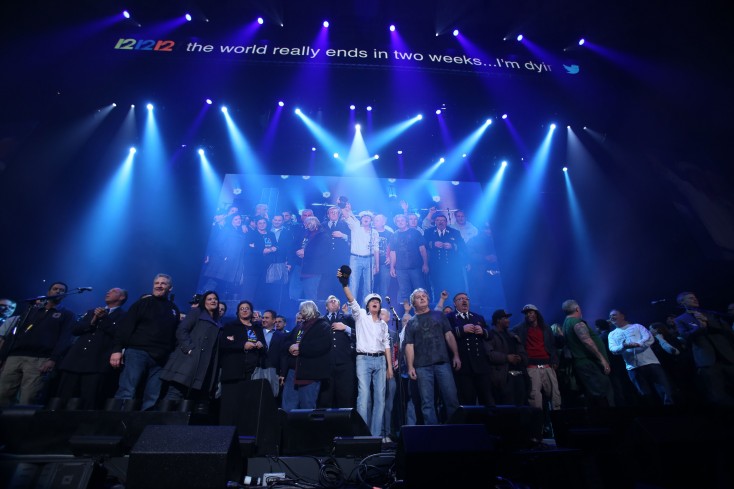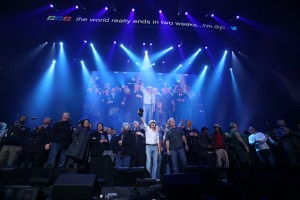By ANGELA DAWSON
Front Row Features
HOLLYWOOD—On December 12, 2012, some of entertainment’s most iconic names came together at Madison Square Garden for a historic concert to benefit the victims of Hurricane Sandy. It was put together just six weeks after the disaster by some of the top leaders of the entertainment industry on behalf of Robin Hood, New York’s largest poverty-fighting organization.
“12-12-12” is a documentary that captures the unprecedented gathering of talent who turned up on stage to raise over $50 million in one night for the Robin Hood Hurricane Sandy Relief Fund to support organizations helping victims in New York, New Jersey and Connecticut. It blends concert footage with rehearsals, behind-the-scenes drama and images of the devastation left in Sandy’s wake as well as the camaraderie of New Yorkers coming together to help each other after the storm.
The evening’s Emmy Award-nominated telecast included performances by some of the music industry’s legendary acts: Bruce Springsteen and the E Street Band, Billy Joel, Alicia Keys, Paul McCartney, Dave Grohl, Roger Waters, Eddie Vedder, Chris Martin, Michael Stipe, Adam Sandler, Eric Clapton, Jon Bon Jovi, The Rolling Stones, The Who, Kanye West. It also included involvement from the entertainment and media elite including Billy Crystal, Susan Sarandon, Kristen Stewart, Jon Stewart, Chelsea Clinton, Jimmy Fallon, Stephen Colbert, Sean Combs, Steve Buscemi, Chris Rock, Seth Meyers, Jake Gyllenhaal, Katie Holmes, Jamie Foxx, Quentin Tarantino and Christoph Waltz.
Amir Bar-Lev, a documentary filmmaker whose prior work includes “The Tillman Story” and “My Kid Could Paint That,” served as co-director on the history-making concert, alongside veteran music documentarian Charlie Lightening. In the days leading up to the fundraising event, confusion loomed as to who was going to shoot the documentary, an effort that included 23 camera crews set up in various locations throughout the massive New York City venue. Each crew collected about six hours of footage, which was edited down to this two-hour-plus film. As the hours ticked down to show time, Bar-Lev and Lightening remembered why they were there and a spirit of cooperation overcame creative differences and egos.
With the documentary, produced by Weinstein, along with John Sykes, president of Clear Channel Entertainment and Jim Dolan, executive director of the Madison Square Garden, coming out just weeks after the year anniversary of the disaster and a few weeks before the anniversary of the concert, Bar-Lev spoke by phone from New York about what it was like to take on such a sizeable and yet unforgettable experience. All proceeds from the film go to the Robin Hood Hurricane Sandy Relief Fund to help the victims of the storm that are still dealing with the aftermath of its destruction.
Q: How did you get involved?
Bar-Lev: The story starts for me on my last film, “The Tillman Story,” which was distributed by the Weinstein Co. That was in 2010. A week or so before this concert happened, I was at a screening with my wife and I saw (studio chairman) Harvey Weinstein. I tapped him on the shoulder and he said, “I’ve been thinking about you. I want you to make this film for me.” He told me about the concert coming up. I though he was just being nice. The next day, they called me.
Q: How did you feel about it? Were you under a lot of pressure?
Bar-Lev: It was super duper last minute. In fact, we got our budget approved just days before the concert. We started filming and the first funny thing that happened was I noticed there was this one guy at the production meetings who was kind of giving me a funny look. I was like why is this guy angry at me. It turned out Paul McCartney also had the idea of documenting this concert in the run up to the concert. It turned out this man was Paul McCartney’s manager and he was wondering why there was another crew doing the same thing they were doing.
Q: How did you resolve the problem?
Bar-Lev: The tension built until the day of the concert when it came to a head. We got in a fight over who was going to interview Adam Sandler. This fight got acrimonious and there was a lot of finger pointing. And then there was a moment where we both looked at each other and said, “This is crazy. We’re fighting each other over a charity concert.” We said to each other, maybe we can join forces. So, literally, hours before the concert we had a production meeting with their team and shook hands and divvied up the work. All of us brought different skills to the table. I think it reflects the defensibility and the tone that the producers of the concert set at the outset—which was a very generous, ad-hoc, collaborative, DIY approach which we adopted for the documentary.
Q: Once you came to an agreement, how did you divvy up the work?
Bar-Lev: They handled most of the interviews because they had the soundproof room and also had the relationship with (executive producer and performer) Paul McCartney that we didn’t have. I’d hired many of my favorite documentary people in New York. We did more of the documentary stuff—the vox pops (interviews with the audience), the green room and the control room. It was very seat of the pants. It was improvisational, like the production of the concert. We didn’t have a grand master plan. What passed for a plan we put together at 6 p.m. the night of the concert.
Q: The big dramatic moment in the film is when Google chairman Eric Schmidt comes to the rescue when the computer system collecting the donations crashes. Did you witness that?
Bar-Lev: Yeah. It was so interesting to watch and see how these things get fixed. Things like that aren’t fun to watch as they’re happening. The production meetings don’t really make great cinema so we didn’t spend that much time in there. But listening to what (the organizers) were saying was amazing. Somebody would say we need to do this and then somebody else would say, “I know George Soros. I can call him right now.” There was literally a George Soros moment and a President Obama moment. There were 16 titans of business around this table you see in the film and they were having that type of conversation: “I can call Obama.” It’s cool to look back on it. We happened to catch a good moment that represented the other ones. Yeah, Eric Schmidt seeming to fix the Internet with a phone call.
Q: Was there anything you shot or were trying to shoot that you were asked not to use?
Bar-Lev: Not really. You’re catching the performers and the producers who were very open to our cameras being around. You’re catching them in a very human mode, when they’re very generously giving of their time and space. That’s one thing I’m excited about in the film that you see is people who normally are very managed being candid and unmanaged. You see them as human beings, like Paul McCartney in his dressing room talking with Billy Joel. I wanted to try to reflect what I saw, which is less about celebrity culture and more about the spirit of New York.
Q: Was it difficult to decide which footage to use?
Bar-Lev: One of the things we didn’t want to have happen was to have a bunch of editors working on this. We wanted one editor who would put in the time and the brains to get his or her head around a vast trove of material we had gathered. I have a fantastic editor named Ben Gold. We had 23 cameras with six hours of footage (each) so it was a lot of footage to go through. Ben and I came up with a grammar for the film that keeps you moving. There were times when the film wasn’t working and we were soliciting opinions from folks and they were saying, “You’re going to have to lose that,” and we resisted (cutting). We decided we’d keep tinkering to make this thing work. There are times when you feel like you want to stay on the stage but then you realize you need to go someplace else and it’s even cooler, and we’ll come back to the stage shortly. The narrative snakes around this one building where many interesting things were happening over a six-hour period.
Q: How involved was Paul McCartney and his team after the show?
Bar-Lev: We took that on, myself and Ben, the producers and our edit team. That didn’t make sense to do by committee.
Q: How much of the proceeds from this go to the Robin Hood Foundation?
Bar-Lev: 100 percent. Everything is for Robin Hood. Not one iota is going to the producers, the filmmakers or anybody like that.
Q: Did Hurricane Sandy affect you personally?
Bar-Lev: I live in a part of Brooklyn that wasn’t affected but my wife and I jumped on our bikes and biked around the city (after Sandy). It was so moving to see how New Yorkers act under those circumstances. We saw big block parties happening where people are barbecuing and sharing food and helping each other charge their cell phones. We went and volunteered. It was a real outpouring of generosity. We’re often told to look out for each other and if something terrible happens, look out for riots. But nothing like that happened. The absence of authority, in a way, made people bring out their best. At times like that you feel inspired. I felt inspired about being part of this city, this country and people know what to do instinctively.





